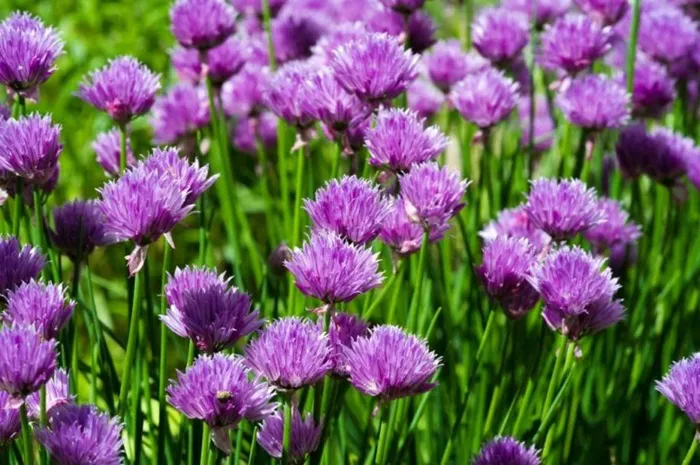In the realm of gardening, few plants offer the delightful combination of aesthetic charm and practical utility like chives. While their slender, green leaves are a familiar sight in many herb gardens, it is the chive flower that truly captures the imagination. These blooms are not only a feast for the eyes but also a testament to the wonders of nature’s design. Let’s delve into the captivating world of chive flowers and explore their unique characteristics.
The Allure of Chive Flowers
A Closer Look at the Structure
Chive flowers are a marvel of botanical architecture. Each flower is composed of a cluster of florets, typically numbering between 20 and 30, arranged in a spherical or hemispherical shape. The florets are connected to a central stem, forming a delicate, rounded inflorescence. This structure gives the chive flower its characteristic pom-pom appearance, reminiscent of a tiny, natural bouquet.
The Color Palette
Chive flowers are renowned for their vibrant hues. The most common color is a rich, deep purple, which can vary from a soft lavender to a more intense violet. Occasionally, white chive flowers can be found, adding a touch of elegance and purity to the garden. The petals of the florets are usually narrow and pointed, with a slightly translucent quality that allows light to pass through, creating a shimmering effect.
The Scent and Texture
When it comes to sensory appeal, chive flowers do not disappoint. They emit a subtle, yet distinctive fragrance that is both sweet and slightly oniony. This scent is a gentle reminder of their botanical relationship to onions and garlic. The texture of the flowers is soft and velvety to the touch, making them a delightful addition to any garden.
The Lifecycle of Chive Flowers
Blooming Season
Chive flowers typically bloom in late spring to early summer, usually between May and June in temperate climates. This timing makes them a welcome sight after the long, cold winter months. The flowers last for several weeks, providing a prolonged period of visual and aromatic pleasure.
Growth and Development
Chives are perennials, meaning they return year after year. The flowers emerge from the tips of the long, hollow leaves, which grow in clumps. As the flower buds develop, they gradually expand, revealing their intricate structure. Over time, the flowers mature and eventually give way to seed pods, which can be harvested for future planting.
The Role of Chive Flowers in the Garden
Aesthetic Value
Chive flowers are a versatile addition to any garden. Their compact size and rounded shape make them ideal for borders, rock gardens, or as a filler in larger plantings. They add a pop of color and texture, enhancing the overall visual appeal of the garden. Whether planted in clusters or interspersed with other flowers, chive flowers bring a sense of whimsy and charm.
Attracting Pollinators
In addition to their aesthetic benefits, chive flowers play a crucial role in supporting local ecosystems. Their nectar-rich blooms attract a variety of pollinators, including bees, butterflies, and other beneficial insects. By providing a food source for these creatures, chive flowers help to promote biodiversity and support the health of the garden.
Culinary Uses
Chive flowers are not just for show; they are also edible. Their mild onion flavor makes them a delightful addition to salads, soups, and other dishes. The flowers can be used fresh or dried, adding a touch of natural flavor and color to culinary creations. Incorporating chive flowers into your cooking is a wonderful way to enjoy their unique taste and bring the garden to the table.
Caring for Chive Plants
Planting and Soil Requirements
Chives are relatively easy to grow and thrive in a variety of conditions. They prefer well-drained soil that is rich in organic matter. A sunny location is ideal, although chives can tolerate partial shade. When planting, space the plants about 6 to 8 inches apart to allow for healthy growth and airflow.
Watering and Maintenance
Chives require regular watering, especially during dry periods. However, they are also drought-tolerant and can survive with less frequent watering once established. To maintain the health of the plants, remove any dead or yellowing leaves and spent flower heads. This practice encourages new growth and helps to prevent the spread of disease.
Pests and Diseases
Chives are generally hardy and resistant to most pests and diseases. However, they can occasionally be affected by aphids or onion flies. Regular inspection and prompt treatment with organic insecticides can help to keep these issues under control. Overall, chives are a low-maintenance plant that rewards gardeners with their beauty and utility.
Conclusion
Chive flowers are a delightful addition to any garden, offering a unique blend of beauty, fragrance, and practicality. Their charming appearance and versatility make them a favorite among gardeners and chefs alike. By understanding the characteristics and needs of chive flowers, you can enjoy their presence in your garden for years to come. Whether you are a seasoned gardener or a beginner, chives are sure to bring joy and inspiration to your outdoor space.


